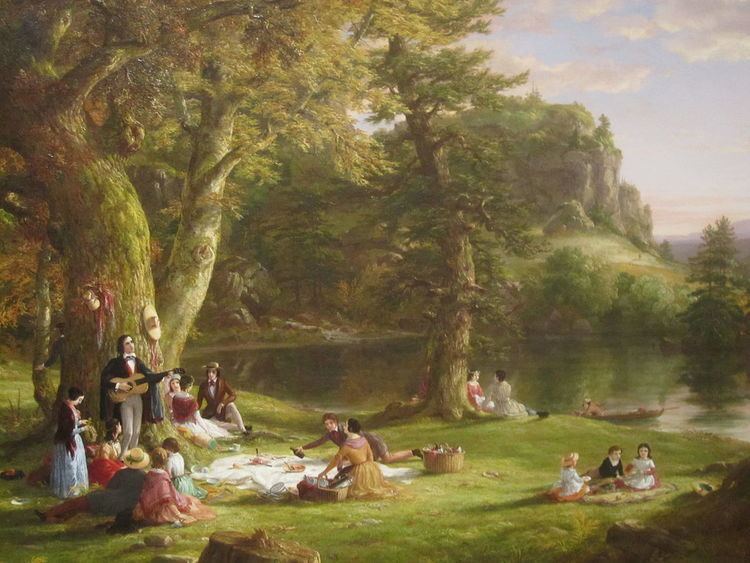 | ||
A picnic is an excursion at which a meal is eaten outdoors (al fresco), ideally taking place in a scenic landscape such as a park, beside a lake or with an interesting view and possibly at a public event such as before an open-air theatre performance, and usually in summer. Descriptions of picnics show that the idea of a meal that was jointly contributed and was enjoyed out-of-doors was essential to a picnic from the early 19th century.
Contents
Picnics are often family-oriented but can also be an intimate occasion between two people or a large get-together such as company picnics and church picnics. It is also sometimes combined with a cookout, usually a form of barbecue; either grilling (griddling, gridironing, or charbroiling), braising (by combining a charbroil or gridiron grill with a broth-filled pot), baking, or a combination of all of the above.
On romantic and family picnics, a picnic basket and a blanket (to sit or recline on) are usually brought along. Outdoor games or some other form of entertainment are common at large picnics. In established public parks, a picnic area generally includes picnic tables and possibly other items related to eating outdoors, such as built-in grills, water faucets, garbage containers, and restrooms.
Some picnics are a potluck, an entertainment at which each person contributed some dish to a common table for all to share. When the picnic is not also a cookout, the food eaten is rarely hot, instead taking the form of deli sandwiches, finger food, fresh fruit, salad, cold meats and accompanied by chilled wine or champagne or soft drinks.
Etymology
The first usage of the word is traced to the 1692 edition of Tony Willis, Origines de la Langue Française, which mentions pique-nique as being of recent origin; it marks the first appearance of the word in print. The term was used to describe a group of people dining in a restaurant who brought their own wine. The concept of a picnic long retained the connotation of a meal to which everyone contributed something. Whether picnic is actually based on the verb piquer which means 'pick' or 'peck' with the rhyming nique meaning "thing of little importance" is doubted; the Oxford English Dictionary says it is of unknown provenance.
The word picnic first appeared in English in a letter of the Gallicized Lord Chesterfield in 1748 (OED), who associates it with card-playing, drinking and conversation, and may have entered the English language from this French word. The practice of an elegant meal eaten out-of-doors, rather than an agricultural worker's dinner in a field, was connected with respite from hunting from the Middle Ages; the excuse for the pleasurable outing of 1723 in François Lemoyne's painting (illustration, left) is still offered in the context of a hunt.
In approximately 1999 an internet rumor began to be spread claiming a racist origin for the word "picnic", and connecting it with the lynching of blacks in the American South. The spurious etymology behind this rumor has since been thoroughly debunked; however, the rumor still occasionally resurfaces.
Related historical events
After the French Revolution in 1789, royal parks became open to the public for the first time. Picnicking in the parks became a popular activity amongst the newly enfranchised citizens.
Early in the 19th century, a fashionable group of Londoners (including Edwin Young) formed the 'Picnic Society'. Members met in the Pantheon on Oxford Street. Each member was expected to provide a share of the entertainment and of the refreshments with no one particular host. Interest in the society waned in the 1850s as the founders died.
From the 1830s, Romantic American landscape painting of spectacular scenery often included a group of picnickers in the foreground. An early American illustration of the picnic is Thomas Cole's The Pic-Nic of 1846 (Brooklyn Museum of Art). In it, a guitarist serenades the genteel social group in the Hudson River Valley with the Catskills visible in the distance. Cole's well-dressed young picnickers having finished their repast, served from splint baskets on blue-and-white china, stroll about in the woodland and boat on the lake.
The image of picnics as a peaceful social activity can be utilised for political protest, too. In this context, a picnic functions as a temporary occupation of significant public territory. A famous example of this is the Pan-European Picnic held on both sides of the Hungarian/Austrian border on the 19 August 1989 as part of the struggle towards German reunification.
In 2000, a 600-mile-long picnic took place from coast to coast in France to celebrate the first Bastille Day of the new Millennium. In the United States, likewise, the 4 July celebration of American independence is a popular day for a picnic. In Italy, the favorite picnic day is Easter Monday.
In film
In fine art
In literature
"The Rat brought the boat alongside the bank, tied it up, helped awkward Mole safely ashore, and swung out the picnic basket. The Mole begged to be allowed to unpack it all by himself. He took out all the mysterious packets one by one and arranged their contents, gasping 'Oh my! Oh my!' at each fresh surprise."
